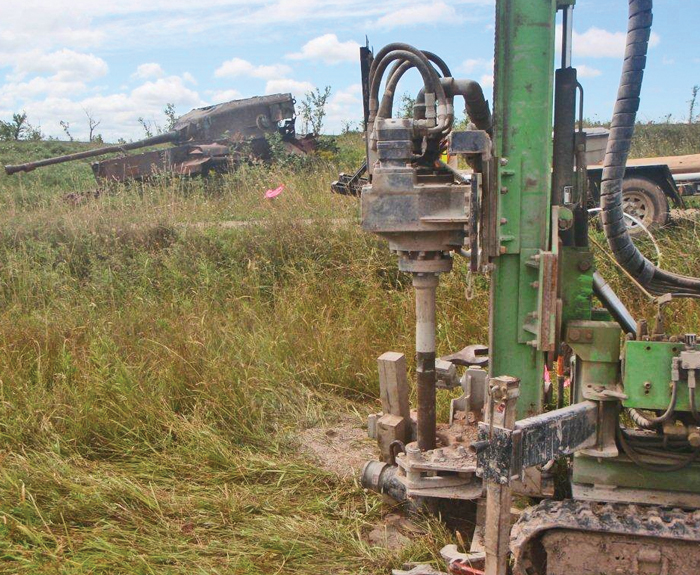A Drill Rig Specs Guide
Selecting a geothermal drilling rig can feel a little like a high performance car comparison. The difference being instead of brake horsepower and 0 to 60 stats, the specifications under analysis are pullback, pushdown and rotary torque. What do these terms mean, and how do they relate to your drilling requirements? Let’s look below.
 Pullback: Retraction force applied when recovering the drill string from the borehole and measured by weight (pounds/kilograms) is pullback. The required pullback depends mainly on the weight of the drill string which is determined by the bore depth; however, extra power is often necessary when trying to recover a jammed or backfilled drill string due to the borehole collapsing and to allow for other contingencies. Therefore, a safety factor of 40 to 50 percent pullback capacity loss should be accounted for. For example, a drill rig such as the K60 having 22,000 lbs of pullback at 50 percent capacity will retract 137 drill rods, 10 ft long, weighing 80 lbs each (in other words, a drill string of 1,370 ft). Pullback is vital in determining depth capacity as the rig must have sufficient power to be able to retract the drill sting.
Pullback: Retraction force applied when recovering the drill string from the borehole and measured by weight (pounds/kilograms) is pullback. The required pullback depends mainly on the weight of the drill string which is determined by the bore depth; however, extra power is often necessary when trying to recover a jammed or backfilled drill string due to the borehole collapsing and to allow for other contingencies. Therefore, a safety factor of 40 to 50 percent pullback capacity loss should be accounted for. For example, a drill rig such as the K60 having 22,000 lbs of pullback at 50 percent capacity will retract 137 drill rods, 10 ft long, weighing 80 lbs each (in other words, a drill string of 1,370 ft). Pullback is vital in determining depth capacity as the rig must have sufficient power to be able to retract the drill sting.
Pushdown: Also called pulldown, crowd force, thrust or weight on the bit (WOB), pushdown refers to the downward pressure applied to the drill string and is measured in weight (pounds/kilograms). The pushdown required is determined by the hardness of the material being drilled and the drill bit. Mud rotary bits drilling in soft formations are run with lower weight (1,100 to 3,000 lbs per inch of bit diameter) than harder formations which can require up to 5,000 lbs per inch of bit diameter. As more weight/drill pipe is added to the drill string, less pushdown is required from the rig. When DTH (down the hole) hammer drilling, since the air compressor is providing much of the force for each hammer blow, much less pushdown is required. A general rule of thumb is 500 lbs per inch of bit diameter.

Stroke: Also called feed, stroke measures the distance that the rotation head travels from top to bottom of the drill rig’s mast. It is generally the height of the mast minus the height of the rotation head and the clamping system. While mast height is important in defining headroom, stroke determines the length of drill rods that can be used.
Torque: The turning force of the drill head measured in ft-lbs or Newton metres (Nm), which is applied to the bit, auger or drill string, is called torque. A torque meter or hydraulic gauge on the drill rig indicates how much torque is being applied. Experienced drillers often estimate torque from vibration on the drill string and/or engine noise and behavior. Auger drilling requires much more torque (5,000 to 10,000 ft-lbs depending upon application) compared with mud rotary or DTH drilling (generally below 5,000 ft-lbs). Lower torque drilling units are sometimes measured in inch-pounds.
Other important specifications that should be compared when selecting a geothermal drilling rig include weight, length and width for determining transportation requirements and drill site impact. Mast movement (side to side and fore/aft) should be considered to allow for angle drilling, such as is necessary for Direct Exchange (DX) loop systems. And of course, if on-board, will the mud pump volume (gpm or gallons per minute) and pressure (psi or pounds per square inch) or air compressor volume (CFM or cubic feet per minute) and pressure (psi) be adequate for the drilling method and ground conditions?
To most people, 10,000 ft-lbs of rotary torque may not be as exciting as 0 to 60 in less than 4 seconds, but to a driller, it sure comes close.
Brandon Wronski is an equipment specialist with RigKits LLC, based in Charlotte, N.C.
